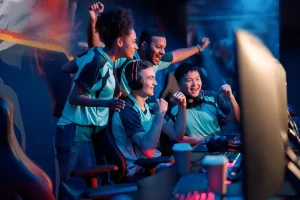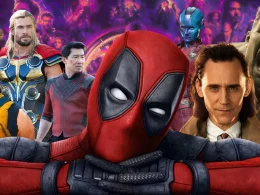Introduction
Esports, short for electronic sports, is the world of competitive video gaming. It has grown from small local tournaments to massive global events, drawing millions of viewers. Today, esports is a major player in live entertainment, alongside traditional events like concerts and sports.
This article will look at how esports is changing live entertainment. We’ll explore how it attracts viewers, the technology behind it, and how it fits into our entertainment culture.
The Rapid Growth of Esports

Esports has become incredibly popular in just a few years. The global audience for esports is expected to reach over 700 million people by 2027. Many people watch esports on streaming platforms like Twitch and YouTube, where they can see players and teams compete in real-time.
These events are no longer just online. Large stadiums are now hosting esports tournaments, with thousands of fans attending in person. Popular events, like The International (Dota 2) and the League of Legends World Championship, attract huge crowds, rivaling major sports events.
Esports vs. Traditional Sports

Esports has become a strong competitor to traditional sports, especially among younger people. Here’s why:
- Easy to Watch: Unlike traditional sports, which require fans to go to games or pay for cable TV, esports can be watched online, often for free. Viewers can tune in from anywhere in the world.
- Fan Interaction: Esports is more interactive than traditional sports. Fans can chat with players, vote in polls, and even help decide the outcome of certain games. This creates a deeper connection between fans and the action.
- Global Reach: Esports is popular all around the world. A League of Legends tournament, for example, attracts viewers from nearly every country. Traditional sports are often limited to specific regions or countries.
Technology in Esports Live Entertainment

Technology has helped esports grow. New tools and innovations are making the experience better for both fans and players. Some of these changes include:
- Better Streaming: Esports events are streamed in high definition, so viewers can enjoy the action clearly. With 4K and 8K resolution, the experience is closer to being there in person.
- Virtual Reality (VR) and Augmented Reality (AR): These technologies let fans feel like they’re at the event, even if they’re watching from home. VR and AR are still new to esports, but they’re expected to grow in the future.
- Advanced Broadcasts: The way esports are broadcast has improved, too. With multiple camera angles, live stats, and interactive features, viewers can get a better look at the action, making it more exciting to watch.
Esports and Culture

Esports is also changing our culture. It has its own stars, fanbases, and even influences on fashion and music. Here are some ways esports is shaping culture:
- Esports Stars: Some players have become celebrities. People like Ninja and Faker have millions of followers on social media. These players are not only known for their skills but also their influence on fans.
- Esports Communities: Fans of esports are part of a global community. They support their favorite players and teams, just like traditional sports fans cheer for their teams.
- Mixing with Other Entertainment: Esports is merging with other entertainment forms. For example, music festivals now include esports competitions, and esports stars appear on TV shows and in ads. This connection is helping esports become more widely accepted.
Esports as a Global Phenomenon

Esports has become a global phenomenon, reaching audiences far and wide. While traditional sports are often limited to certain countries or regions, esports attracts fans from all over the world. No matter where you live, you can watch your favorite teams and players compete in real time. This global reach helps bring people together, no matter their background, and makes esports an international community.
Esports and the Traditional Sports Industry

Esports is starting to blur the lines between traditional sports and video gaming. Many traditional sports teams and organizations are investing in esports, creating their own teams or partnerships. This crossover is helping esports gain credibility and legitimacy, showing that it’s not just a passing trend. In the future, we may see esports tournaments take place alongside major sports events, offering fans an exciting mix of competition.
Esports as a Career Path
For many players, esports has become a serious career. Professional gamers can make a living through tournament winnings, sponsorship deals, and streaming. Teams and organizations have coaches, analysts, and support staff, creating job opportunities beyond just the players. As the industry grows, we may see more people pursuing careers in esports, both on and off the screen, making it a well-established profession.
Esports and the Impact on Gaming Culture

Esports is also shaping gaming culture itself. It has given rise to a new kind of professional gamer who is seen as a celebrity by fans. Many gamers now have large social media followings, where they share their experiences, strategies, and personal lives. This has changed the way people view gaming. No longer is it just a hobby—it’s become a global sport with its own stars, events, and fanbase.
Building Strong Communities Through Esports
One of the unique aspects of esports is the community it builds. Fans of esports often feel a strong sense of belonging. Whether it’s cheering for a favorite team, talking strategy, or simply discussing the latest matches, esports fans connect with one another. These communities grow online through forums, social media, and live streams, creating a space where everyone, from casual viewers to professional players, can share their passion for gaming.
The Role of Live Streaming in Esports
Live streaming is a crucial part of esports’ success. Platforms like Twitch, YouTube, and Facebook allow fans to watch esports events from anywhere in the world. Streaming also allows viewers to watch matches at their own convenience, which traditional TV can’t always provide. Fans can also see live commentary, player reactions, and even behind-the-scenes footage, making the experience more interactive and engaging.
The Appeal of Esports to Brands and Advertisers

Esports’ growing popularity has attracted many brands and advertisers. Companies see esports as a way to reach younger audiences who are more likely to engage with digital content. Brands often sponsor tournaments, teams, and individual players, which brings money into the industry and helps it grow. As esports continues to grow, we’ll likely see even more businesses investing in this form of entertainment, helping it to become a larger part of mainstream culture.
The Challenges of Esports Live Entertainment
Despite its growth, esports faces some challenges. One of the biggest is the lack of mainstream acceptance compared to traditional sports. While esports is popular among gamers, it still needs to reach a wider audience. There are also issues with player burnout and the pressure to constantly perform at a high level, which can impact both players and the industry as a whole.
The Future of Esports Live Entertainment

Esports is not just a passing trend. It will keep growing as more people get access to faster internet and better streaming technology. Esports events are becoming more immersive with VR and AR, allowing fans to feel like they’re part of the action.
Esports is also blending with traditional forms of entertainment, like concerts and sports. In the future, we may see events that mix gaming with music, fashion, and more, creating an entirely new form of live entertainment.
Comparing Esports Live Entertainment with Traditional Events
To better understand the difference, let’s compare esports with traditional live entertainment in a table:
| Feature | Esports Live Entertainment | Traditional Entertainment |
|---|---|---|
| Audience | Global, mostly online | Usually local, needs TV or tickets |
| Interaction | Fans can chat, vote, and influence events | Mostly passive; little fan interaction |
| Technology | Uses VR, AR, and high-definition streams | Relies on traditional broadcasts |
| Event Length | Multiple-day events with ongoing streams | Typically one-time events, like sports games |
| Fan Experience | Interactive, with real-time updates and engagement | Mostly one-way communication during events |
Analysis Table
| Aspect | Impact of Esports |
|---|---|
| Audience Growth | Millions of viewers, with an expected reach of 700 million by 2027 |
| Revenue | Esports is expected to make billions in revenue |
| Technology | Advances in VR, AR, and streaming technology |
| Cultural Influence | Esports stars and communities shape fashion, music, and online culture |
Esports has shown that it’s more than just a game; it’s a cultural force that will continue to shape live entertainment in the years to come.
Conclusion
Esports is transforming the world of live entertainment. With its growing popularity, cutting-edge technology, and deep fan engagement, esports is setting new standards for how people experience live events. As this industry continues to evolve, it will challenge traditional forms of entertainment and offer new and exciting ways for fans to connect with the action.










